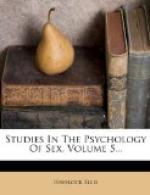When at length the semen is ejaculated, it contains various substances which may be separated from it,[131] and possesses various qualities, some of which have only lately been investigated, while others have evidently been known to mankind from a very early period. “When held for some time in the mouth,” remarked John Hunter, “it produces a warmth similar to spices, which lasts some time."[132] Possibly this fact first suggested that semen might, when ingested, possess valuable stimulant qualities, a discovery which has been made by various savages, notably by the Australian aborigines, who, in many parts of Australia, administer a potion of semen to dying or feeble members of the tribe.[133] It is perhaps noteworthy that in Central Africa the testes of the goat are consumed as an aphrodisiac.[134] In eighteenth century Europe, Schurig, in his Spermatologia, still found it necessary to discuss at considerable length the possible medical properties of human semen, giving many prescriptions which contained it.[135] The stimulation produced by the ingestion of semen would appear to form in some cases a part of the attraction exerted by fellatio; De Sade emphasized this point; and in a case recorded by Howard semen appears to have acted as a stimulant for which the craving was as irresistible as is that for alcohol in dipsomania.[136]
It must be remembered that the early history of this subject is more or less inextricably commingled with folk-lore practices of magical origin, not necessarily founded on actual observation of the physiological effects of consuming the semen or testes. Thus, according to W.H. Pearse (Scalpel, December, 1897), it is the custom in Cornwall for country maids to eat the testicles of the young male lambs when they are castrated in the spring, the survival, probably, of a very ancient religious cult. (I have not myself been able to hear of this custom in Cornwall.) In Burchard’s Penitential (Cap. CLIV, Wasserschleben, op. cit., p. 660) seven years’ penance is assigned to the woman who swallows her husband’s semen to make him love her more. In the seventeenth century (as shown in William Salmon’s London Dispensatory, 1678) semen was still considered to be good against witchcraft and also valuable as a love-philter, in which latter capacity its use still survives. (Bourke, Scatalogic Rites, pp. 343, 355.) In an earlier age (Picart, quoted by Crawley, The Mystic Rose, p. 109) the Manichaeans, it is said, sprinkled their eucharistic bread with human semen, a custom followed by the Albigenses.
The belief, perhaps founded in experience, that semen possesses medical and stimulant virtues was doubtless fortified by the ancient opinion that the spinal cord is the source of this fluid. This was not only held by the highest medical authorities in Greece, but also in India and Persia.
The semen is thus a natural stimulant,




